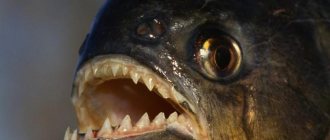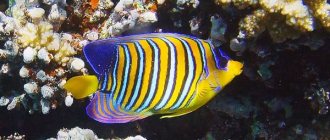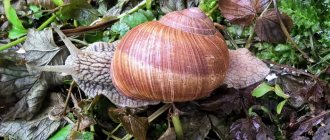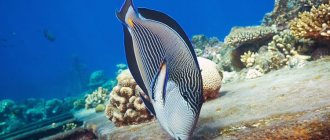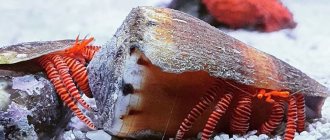Description and features
Ocellaris three-ribbon is a genus of marine fish belonging to the order Perciformes, family Pomacentra. There are approximately 28 species of amphiprions in the world. The clown fish in the photo is shown in all its glory; it is much more convenient to study the description of the species by looking at the picture.
Ocellaris has small dimensions - the length of the largest individuals reaches 11 cm, and the average body size of an inhabitant of the deep sea varies between 6–8 cm. Males are always slightly smaller than females.
The body of the clown fish is torpedo-shaped, slightly thickened on the sides, with a rounded caudal fin. The back is quite high. The head is shortened, convex, with large orange eyes.
On the back there is one forked fin with a black edging. Its front part is very rigid, equipped with sharp spines and consists of 10 rays. On the back, softer part of the dorsal fin, there are 14–17 rays.
Representatives of the genus Amphiprion are famous for their memorable colors. Their typical main body color is yellow-orange. Contrasting bright white stripes with a black outline alternate on the body.
The same thin border adorns the ends of the ventral, caudal and pectoral fins. The latter are very well developed and have a rounded shape. This part of the body of clowns is always brightly colored in the main shade.
The main features of the genus Ocellaris:
- they closely interact with invertebrate polyps of corals, sea anemones, whose tentacles are equipped with stinging cells that secrete deadly poison;
- all newly born fry are males, but at the right moment they are capable of becoming females;
- in an aquarium, clowns live up to 20 years;
- amphiprion can make various sounds similar to clicks;
- Representatives of this genus do not require much attention and are easy to care for.
Reproduction
Each amphiprion has both female and male sets of chromosomes. But they initially develop as males. Each flock is dominated by a pair of male and female, which can reproduce. The remaining males help care for the offspring of the dominant pair. If the female dies, the alpha male mutates and takes her place. The new alpha female then chooses a partner from among the males. Therefore, for reproduction, a couple of males will be enough: they themselves will figure out who lays eggs and who fertilizes them. The main thing is not to acquire two females: reverse transformations are not observed in amphiprions, and the females quarrel with each other for territory so much that both can die in this fight. The main difference between the sexes is size: females are larger.
A pair of amphiprions produces 400-1200 eggs each spawning. There is only one thing that can interfere with their care of the clutch - other fish, so it is better to remove clowns from the general aquarium during spawning, or, on the contrary, remove other fish from it. It’s easy to guess the time: females prefer to lay eggs during the full moon.
In nature, clownfish lay eggs close to their sea anemones. If there are no sea anemones, you will need a secluded place, a hole under a stone. A flat stone, a decorative amphora, or an inverted saucer may be suitable. The entire flock takes care of the future offspring: clowns increase the flow of water near the clutch and remove dead eggs.
The caviar is large relative to the body of the fish, 3-4 mm in diameter. The larvae hatch on 8-9 days. The young are fed immediately after hatching: in nature, the larvae are carried close to the surface by the current, where they grow, feeding on zooplankton, and at this time they are defenseless. After 14 days, the already grown fry return to the reefs, and their coloration appears (light stripes are always the first to appear). This is a good time to move the fry back to the community aquarium.
Kinds
Most natural varieties of Ocellaris clownfish have an orange body color. However, off the coast of Australia there is a species of fish with a black body. 3 white stripes located vertically stand out against the main background. Such a beautiful clown fish is called a melanist.
Common types of clownfish:
- Percula. Found in the waters of the Indian Ocean and the North Pacific. Artificially bred in the US state of Florida. The main color of representatives of this variety is bright orange. Three snow-white lines are located behind the head, on the sides and at the base of the tail. Each of them is outlined by a thin dark edging.
- Anemone ocellaris is a clown fish for children , kids love it very much, because this particular species appeared in the famous cartoon. It has a luxurious appearance - the white lines on the orange body are arranged in such a way that they create several bright sections of equal size. The tips of all fins, except the dorsal one, have a black outline. A distinctive feature of anemone clowns is that they create a symbiosis with different types of sea anemones, and not with just one.
- Chocolate. The main difference between the species and the previous ones is the yellow tint of the caudal fin and the brown tone of the body. Chocolate amphiprions are distinguished by their warlike disposition.
- Tomato (red) clown. The variety reaches 14 cm in length. The main body color is red with smooth transitions to burgundy and even almost black, the fins are fiery. The peculiarity of these fish is the presence of only one white stripe, which is located at the base of the head.
Mostly captive-bred ocellaris are found on sale; they differ from each other in the types of colors. It is useful for every aquarist to know what the features of each of them are:
- Snowflake. This is a fish with an orange body, on which there are very wide white blurry lines. They shouldn't merge. The larger the body area occupied by the snow-white tone, the higher the value of the individual.
- Premium snowflake. In such specimens, the first two stripes are connected to each other, forming large white spots of different shapes in the head and back area. A rather thick black border frames the pattern and the tips of the fins.
- Black ice. This species has orange fins only at the base, and the main part is dark. The body, the color of a tangerine peel, has 3 sections of white, outlined by a thin black border. The spots located on the head and back are connected to each other in the upper part of the body.
- Midnight Ocellaris has a dark brown body. Only his head is painted a muted fiery color.
- Naked. This species of clown fish is distinguished by a monochromatic light orange color.
- Domino is a very beautiful species of amphiprion. Externally, the fish is similar to the midnight clown, but differs from it in the presence of a large white dot in the area of the gill cover.
- Black extreme false-striped. This owner of a spectacular appearance can boast of a black body with a white ring around the head. The stripes on the back and near the tail are very short.
- False striped. This species is characterized by the presence of underdeveloped white stripes. The main body color is coral.
Freshwater clown
Unscrupulous sellers may offer inexperienced aquarists who want to buy a clown fish, but are afraid of not being able to cope with a saltwater aquarium, “the same fish, only freshwater.” We are talking about the clown botia, or macracantha, a representative of the loach family, whose homeland is the cold mountain streams of South America. Her description is a bit like a tropical clown. These are bottom-dwelling fish with bright colors. They can make clicking sounds, but to do this they have to scare the fish: with a click, its spines move into a fighting position. That is why they are trying to pass off the botia as more expensive and popular inhabitants of aquariums.
Botsia are peaceful and unpretentious fish that do not need a marine aquarium and control of a lot of parameters. They are much simpler than amphiprions to keep and breed, but no less beautiful: the body of clown loaches is golden-orange, with three black stripes. But this is a completely different family of fish, which is related to clowns only by the name of one of the species and the stripes on the body. There will be no characteristic funny movements and talkativeness that amphiprion buyers expect. There will only be disappointed expectations. But the botia itself is an excellent aquarium pet when it is not purchased under a false name.
A cartoon that teaches children to be kind has harmed its main characters: clown fish have gained unprecedented popularity among amateur aquarists. Enterprising traders uncontrollably take away young amphiprions from their caring parents. In essence, the plot of the cartoon is repeated, but it will not have a happy ending with a family reunion. Therefore, the task of aquarists is to create optimal conditions for the fish under which a new family is formed.
Lifestyle and habitat
The sea clown fish first described in 1830. The genus of marine fish under discussion is distributed over a large area. Some species are found in the northwestern part of the Pacific Ocean, others in the eastern waters of the Indian Ocean.
Thus, you can meet Ocellaris off the coast of Polynesia, Japan, Africa and Australia. Bright representatives of the marine kingdom prefer to settle in shallow water, where the depth does not exceed 15 meters, and there are no strong currents.
Clown fish live in quiet pools and lagoons. She hides in the thickets of sea anemones - these are sea cnidarians belonging to the class of coral polyps. It is dangerous to approach them - invertebrates secrete poison that paralyzes the victim, after which it becomes prey. Amphiprion ocellaris interacts with invertebrates - cleanses their tentacles and eats leftover food.
Attention! The clown is not afraid of sea anemones; the poison of the cnidarians does not affect her. Fish have learned to protect themselves from deadly toxins. Ocellaris allows itself to be lightly stung by touching its tentacles. Then its body produces a protective mucous secretion, similar in composition to that covering the sea anemone. After this, the fish is in no danger. She settles right in the thickets of coral polyps.
Symbiosis with cnidarians is beneficial for the clown. The poisonous sea anemone protects the motley sea inhabitant from predators and helps to obtain food. In turn, the fish helps to lure the prey into a deadly trap with the help of its bright color. If it were not for the clowns, the cnidarians would have to wait a long time for the current to bring prey to them, because they cannot even move.
In their natural environment, three-ribbon ocellaris can live without an anemone. If the latter are not enough for all fish families, then clowns settle among sea stones, in underwater rocks and grottoes.
The aquarium clown fish does not urgently need to be in the vicinity of cnidarians. If there are other marine inhabitants in the aquarium with it, then Ocellaris will be more comfortable in symbiosis with the sea anemone. When the orange family does not share its water area with other marine inhabitants, it feels safe among the corals and stones.
Connoisseurs of clown fish, experienced aquarists, warn that the cute orange pet shows aggression, protecting the anemone in which it has settled. You need to be careful when cleaning the aquarium - there are cases where fish have bitten their owners until they bled. They are fearless when they fear losing their safe home.
In the marine environment, one anemone is inhabited by an adult pair. Females do not allow other representatives of the genus to approach their shelter, and males drive away male individuals. The family tries not to leave the home, and if it sails away from it, then at a distance not exceeding 30 cm. The bright color helps warn its fellows that the territory is occupied.
Attention! It is important for the clownfish to constantly be in close contact with its anemone, otherwise the protective mucus will gradually be washed away from its body. In this case, the amphiprion risks becoming a victim of its symbiotic partner.
The aquarium clown fish is compatible with almost all varieties of its own kind, with the exception of predators. Guests from the tropics do not tolerate cramped spaces and close proximity to representatives of their kind. In such conditions, competition begins between the inhabitants of the water area. Each adult should have at least 50 liters. water to make the clowns comfortable.
Aquarium characteristics
Water for clowns should be as close in composition as possible to the usual for the habitats of a particular species. The closer, the better, but we will give average characteristics so that you have something to build on when creating an environment for amphiprions.
| Characteristic | Meaning |
| Water temperature | +22…+27 °C |
| Acidity | 7.8-8.5 pH |
| Density | 1.02-1.25 units. |
When populating the aquarium, these parameters are monitored every day, and when the flock is stable, a weekly inspection will suffice. It is produced after replacing 1/5 of the water with fresh water. It is prepared by settling tap water and then dissolving sea salt purchased at an aqua salon in it. Don't try to save money by replacing it with table salt from the grocery store, even if it says "sea" on it. This can kill the fish.
A suitable soil is sea pebbles, which are sorted out before installation, soaked for 4-6 hours in running water, washed thoroughly and then boiled for 3-5 minutes, divided into small portions. It is good to use “living stones” in the design - processed fragments of natural coral reefs.
Daily monitoring is necessary for the operation of all life support systems of the aquarium - not only the compressor and aerator, but also the protein detector. The waste collector must not be overloaded. A high level of water oxygenation is extremely important for anemones if you decide to add them to your clownfish. The peculiarity of these polyps is that they vitally need a large amount of oxygen, and clowns in nature also live in oxygen-saturated water.
Thermometers, instruments that determine the concentration of oxygen, nitrites and ammonia - all this equipment is necessary, as is equipment that controls water heating. Knowing how many degrees there are now in the aquarium is vitally important for its inhabitants: temperature changes are detrimental to clowns, and a constantly elevated reading is harmful to sea anemones.
As territorial fish, clownfish need a lot of space. A pair requires from 50 to 100 liters, and for individual species - 250 liters of volume, and the larger the flock, the larger the aquarium should be. The larger its volume, the greater the chances for peaceful coexistence of amphiprions with other species or even just within a flock.
Nutrition
In their natural environment, Ocellaris eat the remains of their anemone prey. Thus, they cleanse its tentacles of dirt and decaying fibers. List of what the clown fish that lives in the ocean eats:
- animal organisms living at the bottom of the sea, including crustaceans and shrimp;
- algae;
- detritus;
- plankton.
Aquarium inhabitants are unpretentious in matters of nutrition - they feed on dry fish mixtures, which include tubifex, bloodworms, daphnia, gammarus, nettle, algae, soy, wheat and fish meal. Among frozen foods, clowns prefer shrimp, brine shrimp, and squid.
Feeding is done 2 times a day at the same time. During breeding, the frequency of food distribution increases up to 3 times. The fish should not be overfed - excess food may spoil in the water. After eating it, clowns can die.
